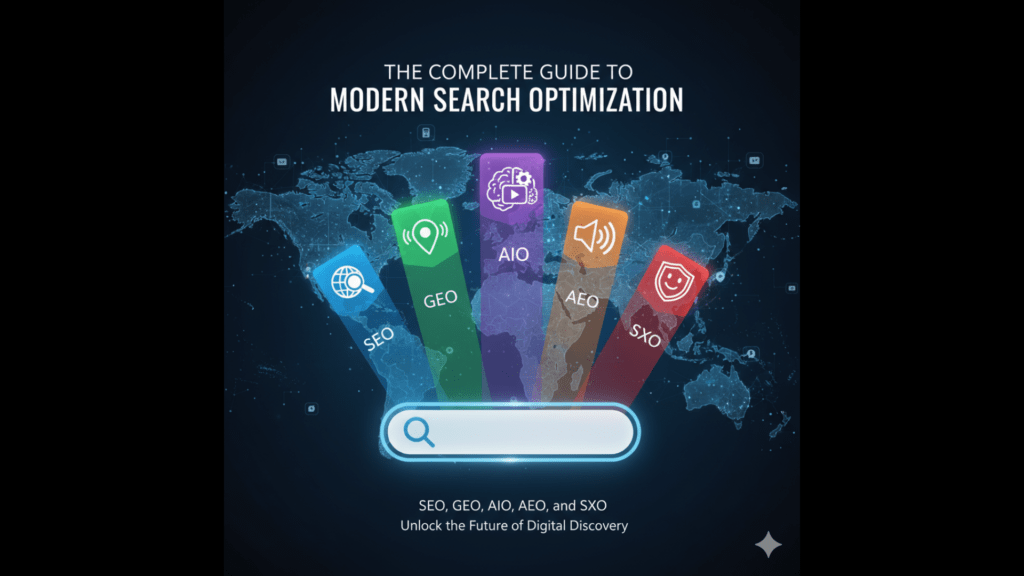The Complete Guide to Modern Search Optimization: SEO, GEO, AIO, AEO, and SXO

Introduction: The Evolution of Search
The digital landscape is transforming rapidly. Traditional search engine optimization is no longer enough. As artificial intelligence reshapes how people find information, businesses must adapt to multiple optimization strategies. This comprehensive guide explores five critical approaches: SEO, GEO, AIO, AEO, and SXO, explaining what they are, why they matter, and how to implement them effectively.
SEO: Search Engine Optimization – The Foundation
What is SEO?
Search Engine Optimization is the practice of improving your website’s visibility in search engine results pages, primarily Google. When someone searches for information, products, or services related to your business, SEO helps ensure your website appears prominently in the results.
Core Components of SEO
On-Page SEO involves optimizing individual web pages through strategic keyword placement, compelling meta descriptions, header tag structure, internal linking, and high-quality content that satisfies user intent.
Off-Page SEO focuses on building your website’s authority through backlinks from reputable sources, social media signals, brand mentions, and overall online reputation management.
Technical SEO ensures search engines can crawl and index your site efficiently. This includes optimizing site speed, mobile responsiveness, XML sitemaps, robots.txt files, structured data markup, and fixing broken links.
Why SEO Still Matters
Despite the emergence of newer optimization strategies, SEO remains fundamental. Google processes over 8.5 billion searches daily, making it the primary gateway through which potential customers discover businesses. Strong SEO builds sustainable organic traffic, establishes brand authority, and delivers long-term ROI without ongoing advertising costs.
SEO Best Practices for 2025
Focus on search intent rather than just keywords. Create comprehensive, authoritative content that thoroughly addresses user questions. Prioritize Core Web Vitals, including page speed and mobile experience. Build natural, high-quality backlinks from relevant sources. Implement schema markup to help search engines understand your content context.
GEO: Generative Engine Optimization – The AI Frontier
What is GEO?
Generative Engine Optimization is optimizing content for AI-powered search tools and language models like ChatGPT, Google’s AI Overviews, Perplexity AI, and Microsoft Copilot. As these tools increasingly answer questions directly rather than providing links, GEO ensures your content is discovered, understood, and cited by AI systems.
How Generative Engines Differ
Unlike traditional search engines that rank web pages, generative engines synthesize information from multiple sources to create original responses. They prioritize authoritative, well-structured content that can be easily parsed and integrated into AI-generated answers.
GEO Strategies
Create content with clear, definitive answers that AI can extract and cite. Use authoritative sources and data to back up claims. Structure information with clear headings and logical flow. Include statistics, facts, and concrete examples that AI systems can reference. Establish topical authority by covering subjects comprehensively across multiple pieces of content.
Ensure your website has strong technical foundations, as AI systems evaluate source credibility. Build a reputation as a trusted authority in your field through consistent, accurate information. Consider how your content answers conversational queries, as users increasingly ask AI systems questions in natural language.
The Future of GEO
As AI systems become more sophisticated, they’ll better understand context, nuance, and user intent. Businesses that position themselves as authoritative sources today will benefit as AI tools increasingly recommend their content. The key is creating genuinely valuable information rather than gaming the system.
AIO: AI Optimization – Training the Algorithms
What is AIO?
AI Optimization focuses on making your content easily discoverable and understandable by artificial intelligence systems across all platforms. While GEO specifically targets generative search engines, AIO encompasses the broader optimization of content for any AI-powered tool or recommendation system.
Why AIO Matters
AI systems power everything from search engines and virtual assistants to recommendation algorithms on social media, e-commerce platforms, and content streaming services. Optimizing for AI ensures your content reaches audiences regardless of which AI-powered platform they use.
AIO Implementation Tactics
Structure your content with semantic HTML that AI can easily parse. Use clear, descriptive language rather than ambiguous phrasing. Implement comprehensive metadata including alt text for images, video transcripts, and detailed product descriptions. Create content clusters that demonstrate topical depth and interconnection.
Use natural language that matches how people actually speak and ask questions. Include relevant entities, facts, and relationships that AI systems can map to their knowledge graphs. Maintain consistency across all platforms to reinforce your brand’s identity and authority in AI training data.
Content Format Considerations
AI systems process different content formats differently. Text remains easiest for AI to understand, but increasingly sophisticated systems can analyze images, videos, and audio. Provide transcripts for multimedia content, use descriptive file names, and include contextual information that helps AI understand the content’s purpose and audience.
AEO: Answer Engine Optimization – Direct Response Strategy
What is AEO?
Answer Engine Optimization focuses on securing featured snippets, knowledge panels, and other prominent answer boxes in search results. When users ask questions, search engines increasingly provide direct answers rather than just lists of links. AEO ensures your content is selected for these prime positions.
Types of Answer Formats
Featured Snippets appear at the top of search results, extracting a concise answer from a web page. They come in various formats including paragraphs, lists, tables, and videos.
Knowledge Panels display comprehensive information about entities like businesses, people, places, or topics, typically on the right side of search results.
People Also Ask boxes show related questions with expandable answers, offering multiple opportunities for visibility.
Local Packs display map-based results for location-specific queries, crucial for local businesses.
AEO Optimization Techniques
Format content to directly answer specific questions. Use question-based headings that match common search queries. Provide concise answers in the first paragraph, followed by detailed explanations. Structure information in lists, tables, or steps when appropriate, as these formats are frequently featured.
Claim and optimize your Google Business Profile for local answer opportunities. Implement FAQ schema markup to increase chances of appearing in People Also Ask sections. Focus on long-tail, question-based keywords that trigger answer boxes.
Measuring AEO Success
Track your featured snippet acquisitions using Google Search Console. Monitor which queries trigger answer boxes and which competitors appear. Test different content formats to see which generate better answer box placement. Remember that answer boxes can significantly increase visibility even if they reduce click-through rates.
SXO: Search Experience Optimization – The Holistic Approach
What is SXO?
Search Experience Optimization combines traditional SEO with user experience design. It recognizes that ranking high in search results is meaningless if visitors immediately leave because of poor site experience. SXO ensures that attracting traffic and satisfying users are equally prioritized.
The User-Centric Philosophy
SXO acknowledges that search engines increasingly measure user satisfaction signals like bounce rate, time on site, and engagement metrics. Google’s helpful content updates explicitly prioritize sites that deliver excellent user experiences. Therefore, technical optimization and user-centric design must work together.
SXO Components
Performance Optimization ensures pages load quickly across all devices. Slow sites frustrate users and hurt rankings. Compress images, minimize code, leverage browser caching, and use content delivery networks to maximize speed.
Mobile Experience is critical since most searches now occur on mobile devices. Responsive design, touch-friendly navigation, readable font sizes, and mobile-optimized content are essential.
Content Quality and Relevance means creating content that genuinely addresses user intent. Match content depth to query type. Someone searching for a quick answer needs different content than someone conducting deep research.
Navigation and Information Architecture help users find what they need intuitively. Clear menus, logical categorization, effective internal linking, and prominent calls-to-action guide users through your site.
Visual Design and Readability impact how users engage with content. Use white space effectively, break text into scannable sections, include relevant images and media, and maintain consistent branding.
Accessibility ensures all users can access and use your site, including those with disabilities. Proper heading hierarchy, alt text, keyboard navigation, and sufficient color contrast benefit everyone while expanding your audience.
Implementing SXO
Start by analyzing user behavior data. Where do users enter your site? Where do they leave? What paths do they take? Use heatmaps, session recordings, and analytics to understand actual user behavior rather than assumptions.
Conduct user testing to identify friction points. What confuses visitors? What prevents conversions? Regular testing reveals issues that data alone might miss.
Create user personas and journey maps to guide optimization decisions. Different users have different needs. Your site should serve multiple audience segments effectively.
Continuously iterate based on feedback and performance data. SXO is not a one-time project but an ongoing commitment to improving user experience while maintaining search visibility.
Integration: Bringing It All Together
The Modern Optimization Strategy
Successful digital presence in 2025 requires integrating all five approaches. They’re not competing strategies but complementary components of a comprehensive approach.
Start with solid SEO fundamentals. Ensure technical excellence, strategic keyword targeting, and quality backlinks. This foundation supports everything else.
Layer in AEO by formatting content to answer specific questions. Structure information for featured snippets while maintaining comprehensive coverage for traditional organic rankings.
Incorporate SXO principles to ensure traffic converts. Fast loading, intuitive navigation, and engaging design turn visitors into customers.
Prepare for the AI future with GEO and AIO. Structure content for machine understanding, establish authoritative positioning, and create cite-worthy information that AI systems will reference.
Prioritization Framework
Different businesses need different emphasis. E-commerce sites should prioritize SXO and technical SEO for conversion optimization. Content publishers benefit heavily from AEO and GEO for maximum visibility. Local businesses must focus on local SEO, answer boxes, and mobile experience.
Evaluate your specific goals, audience behavior, and competitive landscape to determine where to invest resources. Track metrics aligned with business objectives rather than vanity metrics.
Common Mistakes to Avoid
Over-optimizing for algorithms at the expense of user experience creates content that ranks but doesn’t convert. Always prioritize human readers while implementing technical optimizations.
Ignoring mobile users is increasingly fatal. Mobile-first design is no longer optional. Test extensively on various devices and connection speeds.
Chasing every trend without strategic alignment wastes resources. Adopt new techniques that serve your specific goals rather than implementing everything simply because it’s new.
Neglecting content quality for keyword stuffing or artificial optimization hurts both user experience and modern search algorithms that detect low-quality content.
Failing to measure results prevents learning and improvement. Implement robust analytics, define clear KPIs, and regularly assess what’s working.
The Future of Search Optimization
The boundary between different optimization types will continue blurring. Search engines are becoming answer engines. Answer engines are incorporating AI generation. User experience is increasingly central to all algorithmic rankings.
Voice search, visual search, and multimodal search will require new optimization approaches. Content will need to work across text, audio, video, and interactive formats.
Privacy changes and cookie deprecation will shift measurement and targeting strategies. First-party data and contextual relevance will become more important than third-party tracking.
AI will continue transforming how people discover information. Brands that establish themselves as authoritative, trustworthy sources across all platforms will thrive regardless of technological changes.
Conclusion: Building a Future-Proof Strategy
The alphabet soup of optimization acronyms represents a fundamental shift in digital marketing. Success no longer comes from mastering a single channel but from creating exceptional content and experiences that serve users across all platforms and technologies.
Focus on these timeless principles:
Create genuinely valuable content that addresses real user needs comprehensively and accurately. Build technical excellence that ensures fast, accessible, secure experiences across all devices. Establish authority and trust through consistent, high-quality information and positive user experiences. Stay adaptable, continuously learning and evolving as technologies and user behaviors change.
SEO, GEO, AIO, AEO, and SXO aren’t separate silos but interconnected elements of modern digital presence. Master the fundamentals, embrace emerging technologies, and always keep user needs at the center of every decision. That’s the path to sustainable visibility and growth in an ever-changing digital landscape.



